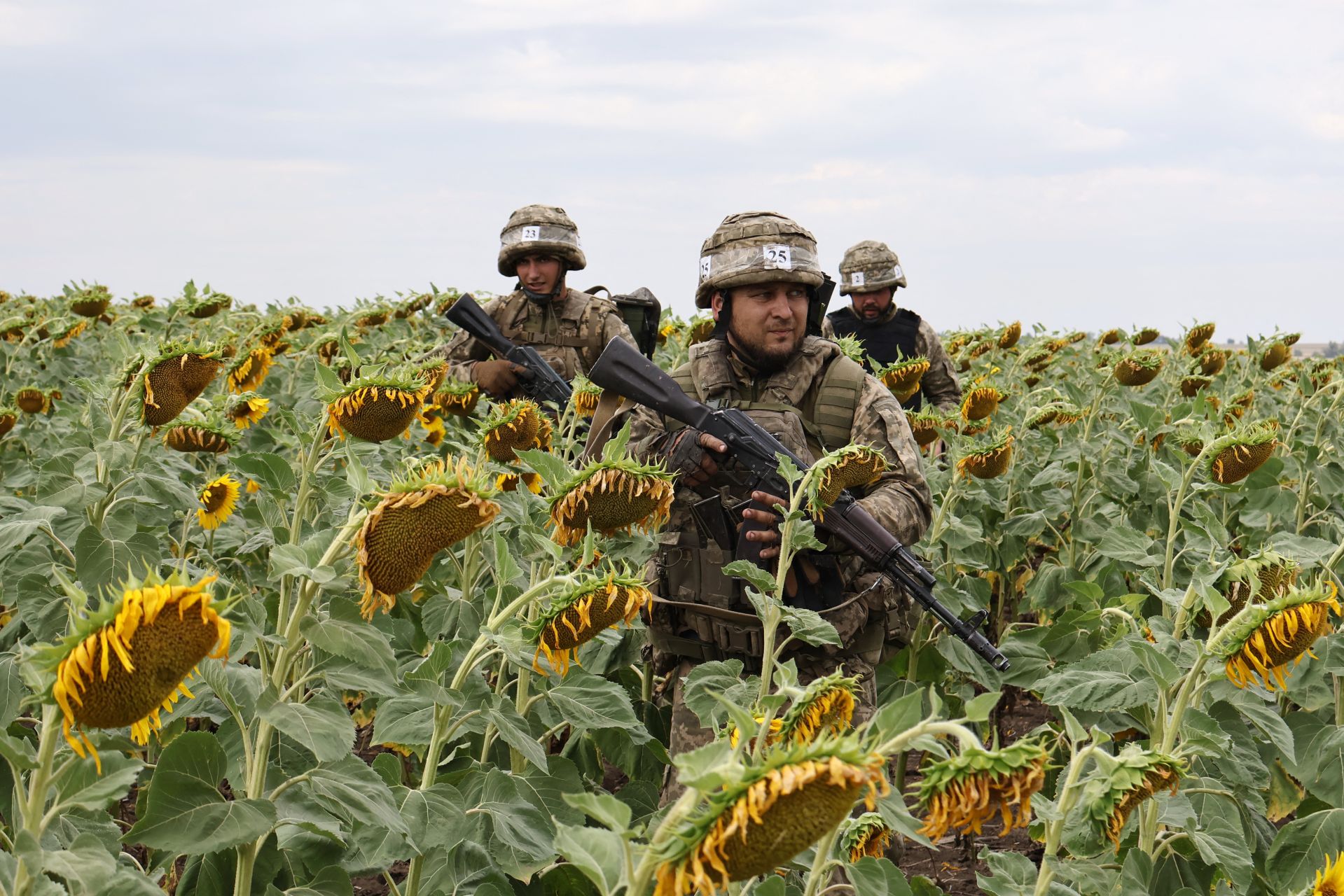- Home
- Middle East
- Ukraine War: Main Developments Since Trump's Inauguration

This handout photograph taken and released by the press service of the 65th Mechanized Brigade of Ukrainian Armed Forces on August 11, 2025, shows new recruits taking part in a training exercise in a sunflowers field at an undisclosed location in the Zaporizhzhia region, amid the Russian invasion of Ukraine. ©Andriy Andriyenko / 65th Mechanized Brigade of Ukrainian Armed Forces / AFP
US President Donald Trump's summit on Friday with his Russian counterpart Vladimir Putin is the latest in a series of diplomatic efforts to end the war in Ukraine since his return to the White House:
'Make a Deal'
While campaigning, Trump had promised to end the Ukraine war in "24 hours."
On January 20, newly inaugurated, he declares that his Russian counterpart, Vladimir Putin, "should make a deal" with Ukraine and then threatens Russia with sanctions.
On February 12, Trump says he and Putin have agreed to start "immediate" talks on ending the Ukraine conflict.
Washington says Ukraine's ambition to join NATO and to return to its pre-2014 borders, before the Russian annexation of Crimea, is unrealistic.
Ukrainian President Volodymyr Zelensky urges his European allies not to back any accord struck by the US behind the backs of Kyiv and Europe.
US and Russian foreign ministers hold talks in Riyadh on February 18, the first at that level since the Russian invasion of Ukraine on February 24, 2022.
Trump-Zelensky Row
In early February, Trump says he wants to negotiate a minerals deal with Ukraine that would give the United States access to its natural wealth in compensation for US economic and military aid already delivered to Kyiv.
On February 15, Zelensky refuses to sign a first US proposal; four days later, Trump lashes out at the Ukrainian leader, going as far as calling him a "dictator."
On February 28 in a spectacular public clash with Zelensky at the White House in front of television cameras, Trump accuses him of having "disrespected" the United States and threatens that if he doesn't make peace with Russia, "we're out..."
On March 3, Trump suspends military aid to Ukraine and the sharing of intelligence.
Zelensky makes conciliatory gestures to Trump.
The 27-nation EU on March 6 approves a plan aimed at mobilizing up to 800 billion euros ($870 million) over four years to boost security on the continent and help Ukraine.
Putin Sets Terms
Washington agrees to lift restrictions on military aid and intelligence sharing after, on March 11, Ukraine and the United States agree to a plan for a 30-day ceasefire with Russia.
Putin accepts a 30-day truce, but only on attacks on energy infrastructure. Both sides trade accusations of breaches.
On March 25, after talks in Saudi Arabia, the White House announces on March 25 after talks in Saudi Arabia, an agreement for a truce in the Black Sea, but Russia sets new preconditions.
In April, Russia carries out more deadly strikes.
Trump shows increasing signs of impatience, accusing Zelensky of compromising the talks by refusing to recognize Russia's sovereignty over annexed Crimea.
He also expresses doubts over Putin's will to end the war.
Minerals Accord
After weeks of negotiations, on April 30 Washington and Kyiv sign a deal giving US companies access to Ukraine's natural resources and creating an investment fund for reconstruction.
As Russia intensifies its attacks on Ukraine, Trump says on May 26 that Putin has gone "crazy" and is "playing with fire."
In mid-June he says he is as disappointed with Ukraine as with Russia.
Ultimatum to Putin
In early July, Washington announces a suspension in its deliveries of some arms to Ukraine, citing concerns over a decline in its own ammunition stocks.
Less than a week later, Trump says he is unhappy with Putin's stance and promises to send more "defensive" weapons to Ukraine via NATO.
After several fruitless rounds of talks in Turkey, Trump gives Putin 50 days to end the war or face tough sanctions, an ultimatum that is then reduced to 10 days and supposed to expire on August 8.
On that day, Trump says he will meet Putin on August 15 in Alaska to talk about an end to the conflict, saying it will involve an exchange of territory.
Meanwhile, US-Russia tensions soar. Trump announces the deployment of two nuclear submarines after what it says are provocative declarations by former Russian president Dmitry Medvedev.
AFP
Read more



Comments